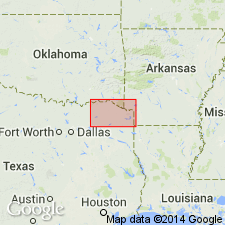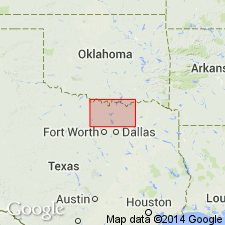
- Usage in publication:
-
- Roxton Limestone
- Modifications:
-
- Mapped 1:250k
- Dominant lithology:
-
- Limestone
- AAPG geologic province:
-
- Ouachita folded belt
Summary:
Roxton Limestone. Sandy, glauconitic, soft, tough, red; marine megafossils common; thickness 10 feet, feathers out eastward. Lies above Gober Chalk and below Ozan Formation. Age is Late Cretaceous.
[Mapped in mostly continuous belt in western part of map sheet, north of North Sulphur River, in Fannin and Lamar Cos., northeastern TX.]
Source: Publication.

- Usage in publication:
-
- Roxton Limestone
- Modifications:
-
- Mapped 1:250k
- Dominant lithology:
-
- Limestone
- AAPG geologic province:
-
- Ouachita folded belt
Summary:
Pamphlet [p. 3]. Roxton Limestone of Austin Group. Sandy, glauconitic, soft, tough, red, marine megafossils common. Thickness 10 feet, feathers out westward near Bailey, Fannin County, northeastern Texas. Lies above Gober Chalk of Austin Group and below Ozan Formation. Age is Late Cretaceous.
[Mapped in Hail-Bailey area, eastern edge of map sheet, in Fannin Co., northeastern Texas.]
Source: Publication.
For more information, please contact Nancy Stamm, Geologic Names Committee Secretary.
Asterisk (*) indicates published by U.S. Geological Survey authors.
"No current usage" (†) implies that a name has been abandoned or has fallen into disuse. Former usage and, if known, replacement name given in parentheses ( ).
Slash (/) indicates name conflicts with nomenclatural guidelines (CSN, 1933; ACSN, 1961, 1970; NACSN, 1983, 2005, 2021). May be explained within brackets ([ ]).

